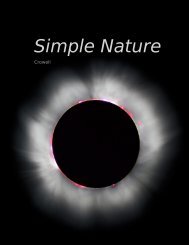Chapter 1 Conservation of Mass - Light and Matter
Chapter 1 Conservation of Mass - Light and Matter
Chapter 1 Conservation of Mass - Light and Matter
Create successful ePaper yourself
Turn your PDF publications into a flip-book with our unique Google optimized e-Paper software.
<strong>of</strong> gravity doesn’t change much if you only move up or down a few<br />
meters. We also find that the gravitational energy is proportional<br />
to the mass <strong>of</strong> the object we’re testing. Writing y for the height,<br />
<strong>and</strong> g for the overall constant <strong>of</strong> proportionality, we have<br />
Ug = mgy . [gravitational energy; y=height; only accurate<br />
within a small range <strong>of</strong> heights]<br />
The number g, with units <strong>of</strong> joules per kilogram per meter, is called<br />
the gravitational field. It tells us the strength <strong>of</strong> gravity in a certain<br />
region <strong>of</strong> space. Near the surface <strong>of</strong> our planet, it has a value <strong>of</strong><br />
about 9.8 J/kg · m, which is conveniently close to 10 J/kg · m for<br />
rough calculations.<br />
Velocity at the bottom <strong>of</strong> a drop example 6<br />
⊲ If the skater in figure g drops 3 meters from rest, what is his<br />
velocity at the bottom <strong>of</strong> the pool?<br />
⊲ Starting from conservation <strong>of</strong> energy, we have<br />
so<br />
0 = ∆E<br />
= ∆K + ∆U<br />
= K f − K i + U f − U i<br />
= 1<br />
2 mv f 2 + mgy f − mgy i<br />
(because K i=0)<br />
= 1<br />
2 mv f 2 + mg∆y , (∆y














